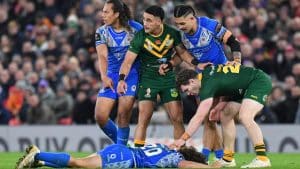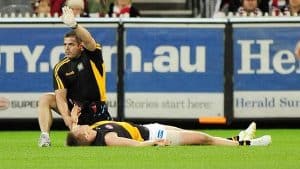Concussions have gained significant attention in recent years due to their potential long-term effects on brain function and overall well-being. These injuries can occur from various activities, ranging from sport-related collisions or accidents in everyday life. One of the best tools we have in managing concussions is the early identification and proper management of these injuries, including baseline testing prior to participation in sport and a comprehensive rehabilitation program following injury.
Concussions occur primarily due to a collision with another person or object, where biomechanical forces to the head or body cause the brain to move rapidly within the skull, resulting in transient neurological impairment. Although more common in contact sports such as rugby and football, concussions can also result from innocent or relatively minor ‘knocks,’ with loss of consciousness only occurring in 10-20% of concussions. Symptoms of concussion can often evolve over hours and days following injury, often resulting in adverse effects on cognitive function and balance, with recovery times varying between individuals. There were almost 3,100 hospitalisations in Australia for concussions caused by sports in 2020-21. Of these:
- Around 2,200 were male and 900 were female
- About 1,300 occurred while playing some form of football
- About 500 occurred while cycling.
Symptoms of concussion may include signs of disorientation, clumsiness, loss of balance and individuals will often display difficulty concentrating and answering specific questions. Diagnosis of concussion can be challenging and is based on clinical signs of the individual compared to their usual self. Therefore, baseline testing can be extremely helpful in accurate and timely diagnosis, especially in adolescents who may under-report their symptoms.

In community sport, the fast and accurate screening for concussion is important to protect participants from further injury, therefore the following guidelines have been made by the Australian Sports Commission’s Concussion and Brain Health Position Statement 2023. If participants display any of the following clinical features (i.e., mandatory signs of concussion) they should be immediately removed from sport/field of play and assessed:
- Loss of consciousness
- Lying motionless for >5 seconds
- No protective action was taken by the athlete in a fall to the ground, directly observed or on video
- Impact seizure or tonic posturing
- Confusion, disorientation
- Memory impairment/amnesia
- Balance disturbance or motor incoordination (e.g., ataxia)
- Athlete reports significant, new, or progressive concussion symptoms
- Dazed, blank/vacant stare or not their normal selves
- Behaviour change atypical of the athlete
Some features suggest more severe injury and any athlete displaying any of these signs should be immediately assessed by a medical professional or referred to the nearest emergency department:
- Neck pain
- Increasing confusion, agitation, or irritability
- Repeated vomiting
- Seizure or convulsion
- Weakness or tingling/burning in the arms or legs
- Deteriorating conscious state
- Severe or increasing headache
- Unusual behaviour change
- Double vision

Once removed from the field, medical professionals can use several screening tools to help identify concussion, including the Sports Concussion Assessment Tool 6 (SCAT6) and Concussion Recognition Tool 5 (CRT5). These tests look at several indicators including balance, memory, sensitivity to light & noise, dizziness, and ability to follow instructions.
Concussion Management
Following the diagnosis of a concussion, individuals are advised to have relative rest for 24-48 hours and should be monitored for ongoing symptoms eg. Over-sleeping or under-sleeping, napping a lot, worsening headaches, and nausea. Where possible, individuals should avoid the use of medication which may mask their symptoms and they should try to avoid complete rest. Usually going for a gentle walk with a hat and sunglasses is a good start. If symptoms last longer than 2-3 weeks, individuals should be referred to their general practitioner or a neurologist for medical review.
How physiotherapy can help!
The role of a physiotherapist in the rehabilitation of concussion is to perform assessments and develop an individualised treatment plan as part of the graded return to sport(GRTS) or activity. For more complex cases, physiotherapists play a crucial role in assisting patients with neck pain, headaches, completing the Visual/Ocular Motor Screening (VOMS) and provide rehabilitation exercises to address neurological symptoms. Part of the GRTS is to identify the safe level to resume exercise without aggravating symptoms and replicate game like scenarios to ensure that athletes are able to return to sport safely, reducing the risk of secondary injuries.
If you have recently experienced a concussion and require an individualised rehabilitation program, or you wish to complete baseline testing for yourself, a family member, or your sporting team, please do not hesitate to reach out to the team at Sound CBR.
https://www.concussioninsport.gov.au/
Concussion and Brain Health Position Statement 2023 https://www.concussioninsport.gov.au/__data/assets/pdf_file/0006/1090680/concussion-and-brain-health-position-statement-2023.pdf